SWOT Analysis: Today’s marina industry
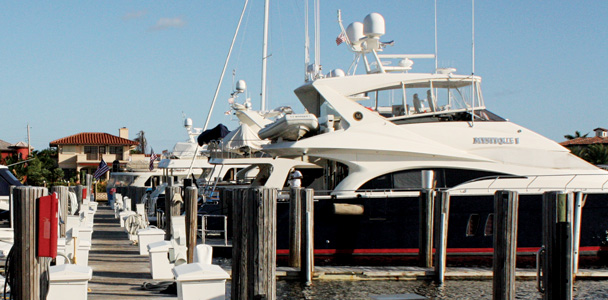
Following visits to six Southeast Florida marinas, Boating Industry examines where the marina industry is headed in 2012 and offers tips for how to run a successful marina business in today’s market.
The International Marina Institute’s fifth annual Southeast Florida Marina Study Tour began with a hurricane bearing down.
On Day 1, Hurricane Rina blew past parts of Central America at speeds just short of a Category 3, and when the group boarded the bus, it was still unclear if it would affect stops around Fort Lauderdale and Miami.
Few events impact a marina more than a hurricane. Of course, one recent event that did was the economic recession, the impact of which is still being felt. That was evident as the tour began with just eight participants, far short of the usual total.
Rina eventually fizzled and ended up missing Florida entirely, allowing the tour to go on as scheduled. As in previous years, it stopped at a half-dozen different facilities with the goal of evaluating and learning from the businesses. Each day ended with participants conducting a SWOT (Strengths, Weaknesses, Opportunities, Threats) analysis of each location visited.

As the marina industry begins to come back from the downturn, it is ripe for a similar analysis. Like much of boating, the marina industry is highly site and region specific. Not all areas experience growth and decline evenly. However, a number of trends seen in the marinas covered by the tour apply to the industry as a whole.
Strengths
In today’s marina industry, the megayacht segment has shown itself to be a bright point.
“Our need for dockage is for bigger boats,” explains Jason Taplin, general manager at Marina Bay in Fort Lauderdale. “We’ve been getting more calls for the 80-foot to 140-foot range and actually have a waiting list. Our smaller boats seem to be affected most and seem to be really shopping the rates.”
Rybovich Superyacht Marina, one of the first stops on the tour, is a good example of this trend. At one of the premiere destinations in the U.S. for larger yachts — up to 245 feet — signs of growth are everywhere: A new 600-ton boat hoist, updated amenities including a gym, lounge and pool for docked crews, and an on-site restaurant under construction. The most important improvement, however, is a recent uptick in billable hours.
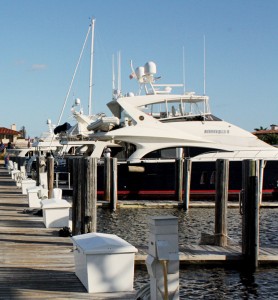
Unlike most businesses, Rybovich has grown since 2008 to more than 250 employees, with 50 additional hires expected by February, according to Jason Sprague, director of business management. Sprague attributes the growth to aggressive sales that earned the company market share as other yards closed.
“There is some pent up spending, but it is still a recovering market,” Sprague says. “Our goal is to get the lion’s share of the business.”
The new business model at Rybovich calls for no seasonal layoffs. During the initial phase of that plan, the company had to be aggressive with rates in order to keep staff on during the summer, actually working at a loss. Since that time, it has managed to raise rates to market value or premium levels. During the growth period, it also let contractors negotiate rates. Now it is dictating the terms.
That aggressive pricing strategy during the recession wasn’t unique, according to Tim Timpson, the veteran marine industry consultant who led the tour. Other marinas that took a hit and reduced prices during the downturn are beginning to take advantage of the recovering market.
“They maintained a high level of customer service, they lowered their prices, they filled the facility and now they’re able to raise the prices,” he explains.
Weaknesses
There are still plenty of lasting effects from the downturn. The current state of the marina industry is preventing much investment in facilities, equipment and people (See Market Focus on Marina Development).
In a flurry of activity in 2006-2007, developers produced a slew of dockominiums and other marina projects, hoping to make a quick buck. The result was a lot of sites that don’t make much sense in today’s market and are now bank-owned.
As in the housing market, the number of marinas for sale at 50 cents on the dollar is preventing many new facilities from being built, and the amount of inventory available in terms of slips is depressing prices. That has created a marina market with little room for investment.
“What’s happened is that the banks have gotten them back, but the people who are managing them for the banks are not necessarily marina professionals, they’re just asset managers,” Timpson says. “And what they’ve done is they’ve cut costs so dramatically that they’ve tarnished the concept of the marina experience.”
With marinas not being run with long-term results in mind, areas like equipment maintenance have been on the receiving end of cuts, which both shortens the lifespan of equipment and poses potential safety issues. Unfortunately, cuts have also come from investments in personnel.
The reduced attendance at the 2011 marina tour is indicative of industry-wide cuts in education spending, says Timpson. A number of years of dramatically reduced revenues have predictably led to dramatically reduced expenditures for training and personnel. In each previous year, the study tour has been two to three times larger, and IMI’s training school has seen similar declines in attendance.
That lack of education threatens to damage the marina industry’s core strength, as a gateway to the pleasure and escape offered by boating.
“This is not just a place to keep a boat, it’s a place to enjoy a boat,” Timpson says. “It’s the experience of boating. We are in the hospitality business.”
As in any industry, the key is professionalism and good customer service, or what Timpson calls “the old fashioned way of doing things.”
Marinas can make themselves more attractive by positioning themselves as a destination rather than just a launch pad. Marina-hosted events can include fishing tournaments, local meetings, weddings and more (See sidebars “Little offerings make great impressions” and “Turn your marina into a venue”).
Opportunities
Perhaps the most important positive indicator for the marina industry is that boat utilization has increased. Typical boat use may have changed, with people taking steps to conserve fuel and reduce costs in other ways, but passion for boating didn’t disappear during the recession.
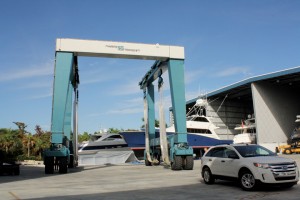
“Everyone fell back in 2008 and said, ‘I’m over my head, I can’t do this,’” Timpson says. “They’ve reconfigured, refinanced, they’ve looked at what it is that they do, and a lot of people are saying ‘the heck with it, I’m going to use my boat — albeit less expensively.’ And utilization seems to be on the upswing.”
During the recession, marinas began offering dockage accommodations that were more or less mothball dockage. Megayachts would let go of the entire crew except the captain and engineer, and in the case of smaller boats, captains were hired by the day and a cleaning crew would occasionally stop in. Owners and their parties basically stayed off the boat for the season. That mothballing has for the most part gone away, according to Sprague at Rybovich.
New ownership opportunities and ways to enjoy the water are also helping drive people back to the water.
Fractional ownership, which has increased dramatically in recent years, represents an opportunity for marinas to serve a growing customer base. Of course, it also presents a challenge, since boats that were being used three or four times a month are now in some cases being used multiple times in a day. That impacts the equipment maintenance and personnel costs, but increased use also means boats will require more repairs, which can be a boon to boatyards.
On the opposite end of the spectrum from yachts, paddle boards are also gaining popularity because they provide an on-the-water experience at a low cost. Marinas that find ways to capitalize on these new trends while their more traditional customers regain their financial footing will reap the rewards.
Threats
Taxes and over-regulation present threats to the marina industry’s nascent recovery.
Tax-strapped communities view marinas as a source of additional revenue. As an example, Timpson cites Barnegat Township, N.J., where marina owners say a recent increase in property taxes and a township-wide property reassessment coupled with a difficult business climate could force closures.
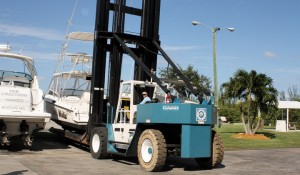
Marinas in the area are still operating at less than full capacity, but the assessed value of many of the properties runs into the millions, which coupled with the property tax increase creates some hefty tax bills for an industry that isn’t as flush with cash as it is sometimes perceived.
Likewise, environmental and boating safety regulations can be extremely valuable (See sidebar: “Running a responsible marina”), but well-meaning laws can also present difficulties for the industry. “Slow speed, no wake” zones, for instance, can effectively increase the distance between a marina and the body of water where a boater wants to end up, making the facility less attractive to boaters. As another example, regulation surrounding dredging can make the process prohibitively expensive, making it more difficult for marinas to cater their facilities to the needs of their clients.
Final analysis
At this point, panic has subsided in the wake of the recession, and the better facilities have responded, allocating their resources more efficiently and otherwise reconfiguring their businesses to fit today’s market.
“People have decided that they do enjoy using boats in the markets that are coming back, and once they have demonstrated that through higher revenues, the marinas can respond by increases in their expenditures,” Timpson says.
With utilization increasing, it is now up to marinas to provide an experience that goes beyond just storing boats. Boating’s core offerings — freedom, stress relief, quality time with friends and family — remain highly prized in today’s hectic world. Marinas need to take advantage of that enthusiasm by catering to new groups like fractional yacht owners, creating a destination atmosphere at their facilities and going out of their way to make the boating experience as enjoyable as possible with great customer service.
“Storage is what happens when you don’t use a boat,” Timpson says. “And when you don’t use it for more than a year, you don’t own a boat. You no longer need it.”
The next generation of boaters is out there right now, and the long-term health of the industry will be determined by whether boating continues to be something that rises to the top of their priority list. For many boaters, a positive marina experience is essential to ensure it will.
The Marinas
Day 1
Lighthouse Point Yacht & Racquet Club
Lighthouse Point, Fla.
The first stop on the tour was Lighthouse Point Yacht & Racquet Club, a traditional yacht club with a restaurant and lounge that serves as a social hub for the local community. Awareness of the facility is spread through word of mouth.
Dockmaster Bob Garey said the Yacht Club utilizes its facilities for weddings and various banquets throughout the year in order to generate additional revenue.
The facility’s business is down but not as badly as many in the Florida marketplace. Garey said they aren’t losing business to other marinas but rather to people who have sold their boats or are buying homes on the water.
Rybovich Superyacht Marina
West Palm Beach, Fla.
Rybovich specializes in the repair and refit of superyachts.
Only a limited number of facilities can handle vessels of the size Rybovich can, and thus much of its competition is international. To help draw that business to the U.S., the company has worked with the Marine Industries Association of South Florida to get business out of Europe and into South Florida.
Using feedback from captains, it has recently worked to improve facilities for the crews docked at the facility. In addition, it now hosts sponsored crew parties and provides a bus to downtown West Palm.
A huge new profit center for the company has been the painting of 60-meter vessels and up, which is technically and logistically difficult to manage but offers huge returns if handled properly.
Harbour Towne Marina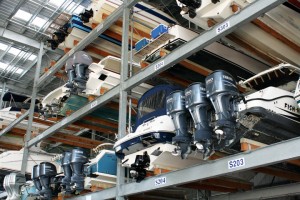
Dania Beach, Fla.
Harbour Towne is a Westrec Marina, the world’s largest full-service marina chain. The 33-acre facility includes more than 150 wet slips and more than 600 drystack spaces. In addition, the site includes 80,000 square feet of office and retail space, providing another revenue stream.
The marina has invested a lot in its dry storage facilities. Having dry storage space for boats up to 45 feet has allowed it to capture a niche that has served the marina well, according to Marina Manager Mike Horn.
Day 2
Marina Bay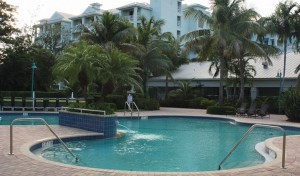
Fort Lauderdale, Fla.
Marina Bay offers 168 deep-water slips for boats from 24 feet to 150 feet and amenities including a pool, gym, theater, billiard room and restaurant.
The marina has done well in recent years with yachts 60 feet and above, and is converting more of its space to accommodate larger vessels. The marina is also currently examining its rates to aggressively pursue the live-aboard market, said General Manager Jason Taplin.
Roscioli Yachting Center
Fort Lauderdale, Fla.
Roscioli Yachting Center is a full-service marina and shipyard offering repairs, carpentry, electrical, fabrication, construction, and painting as well as undercover yacht storage for boats up to 125 feet. It employs more than 125 people and underwent a massive renovation in 2008.
The company has been involved in painting and boat building in Fort Lauderdale for more than 40 years, and that long history has made it a name people in the industry recognize and trust. It faces competition, however, from newer operations that spring up offering bargain rate paint jobs and other services, without the same history of quality work that Roscioli can offer.
Sunset Harbour Yacht Club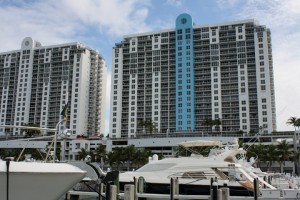
Miami Beach, Fla.
Sunset Harbour, which describes itself as “Miami Beach’s Boutique Marina,” was formed in 2003 as a not-for-profit corporation. It is operated by a board of directors as well as a general manager. The marina offers 125 slips ranging from 45 feet up to 150 feet.
One of the main draws of the facility is its prime location, but being in the heart of Miami Beach also limits the possibility of further expansion. However, the club makes the most of its somewhat limited footprint. Club members have access to a parking spot with each slip as well as an Olympic-size swimming pool and a fitness center. Investment in technology means that members also enjoy wireless and wired high-speed Internet access at each marina dock as well as digital satellite TV, and more facility upgrades are planned for the future.





Excellent Article – but with respect – I could have written it without visiting a marina! SWOT needs to take place on a three monthly basis due to the current economic climate and the fast changing pace of customers wants, needs and expectations.
Timpson is so right in his assessment. I would only add that: “Boats alongside pontoons don’t spend money, people do!” An unused Boat alongside a pontoon does not generate sufficient income per foot to cover the R & M of the pontoon, staffing, depreciation, machinery needed to keep the boat in place, etc etc regardless of its size.
Additionally, I consider that a SWOT analysis does not work unless coupled with a PESTLE analysis (Political, Economic, Scientific, Legal, Environmental) which highlights the changes that are taking place in the marina industry.
In conclusion, my view is that marina’s have been slow to recognise the potential wider demographic of end users of marina’s beyond the scope of just boats – marina’s need to be a place where anyone and everyone visits and this includes a wide range of water sports concessions (beyond just boats) and beyond the eateries / restaurants that customers cannot afford to visit on more than the one special occasion. The educational potential of marinas is also missed as a valuable income source during low seasons.
Regards to ye all…
It was a pleasure having everyone come out to evaluate our marina at Lighthouse Point Yacht & Racquet Club. I have been on several of these marina study tours through IMI and the information we come away with is very valuable.
I was slightly misquoted in this article however. Our marina is constantly looking for new sources of revenue and new ideas. However, the ideas that were discussed during this particular meeting were not feasible due to the business structure of our private yacht club as well as zoning and permitting restrictions.
Happy Boating!